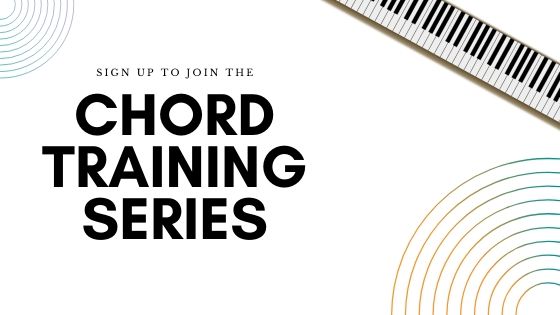Fm Piano Chord – What it is & How To Play It (F Minor Chord)
The Fm piano chord is a minor chord (that's the little m beside the F) and made up of 3 notes - F Ab and C.
This chord is important to learn - all minor chords are - but you'll find it less often than some of the others. So it's important to practice on purpose rather than just when you come across it.
We'll learn more about Fm chord for piano here including:
- Fm piano chord notes
- how to play Fm chord on piano
- Fm chord finger positions
- Fm/Ab chord
- Fm/C chord
- what key Fm chord is in
- and some chord theory
Let's dive in!
Fm Piano Chord Notes
The Fm piano chord notes are F Ab C.
If you are just playing the chords, play F in your left hand and the chord in your right hand.
If you are adding in melody, still keep F as your lowest note but you can be flexible here depending on your level. You can play the whole chord in your left hand and melody in your right hand. Or you can play the melody and the chord in your right with F in the bass.
The inversions below will help with playing melody and chords in your right hand
Fm Piano Chord Chart
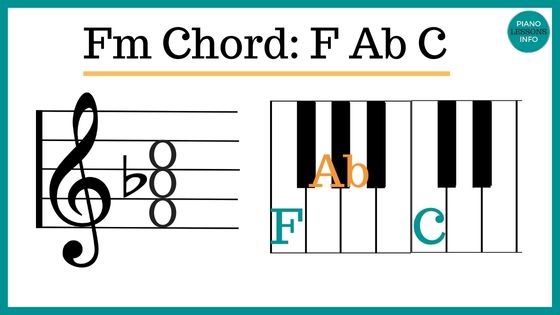
How To Play Fm Chord on Piano
This video will show you how to play Fm chord on piano, how the Fm chord should sound and the fingers to use when playing F minor chord.
Fm Piano Chord Finger Positions
In the beginning, use the classic finger positions (fingering) for the F minor chord.
The Fm piano chord fingers positions are: thumb, middle finger and pinkie in both the right hand and left hand. In piano finger numbers these are fingers 1, 3 and 5.
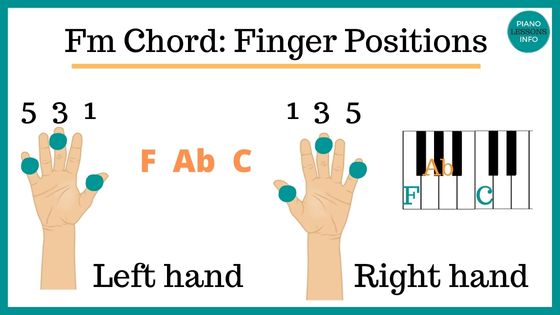
It's good to practice this standard fingering but if you want to break out and use other fingers, once comfortable, go right ahead. It will depend on what else you are playing and where.
This is a good standard place to start for finger positioning.
Fm/Ab Piano Chord
When you see a slash in a chord, for piano, it means to play the note after the slash as your bass note.
When you see Fm/Ab, Ab is your bass note, the lowest note that the left hand will play, and the rest of the notes of the chord will go above that.
I usually play Ab in my left hand and the chord, in this case the Fm chord, in my right hand.
Fm/C Piano Chord
When you see the Fm/C piano chord, it means to play C in the left hand as the lowest note. The other Fm chord notes will go above that in whatever order you'd like.
C is your bass note and played in the left hand.
Fm Chord Inversions
The F minor chord only pops up now and again so it's a great idea to practice it and the Fm chord inversions.
Inversions are the standard positions that you can play a chord in. (More on chord inversions here.)
This helps you to easily find your way into the chord because your muscle memory is helping you out.
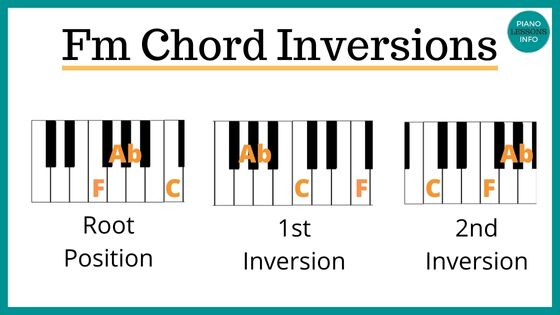
The Fm chord inversions are:
Root position: F AB C
1st Inversion: Ab C F
2nd Inversion: C F Ab
How The Fm Chord is Made (Chord Theory)
There are a number of ways you can think about how the Fm chord is made in terms of music theory and understanding this is useful.
If you know minor scales, you can think of any minor chord as being the 1st, 3rd and 5th notes of the natural minor scale.
However, I find it's great to understand all chords according to the major scale.
So for this chord, we are going to work with the key of F.
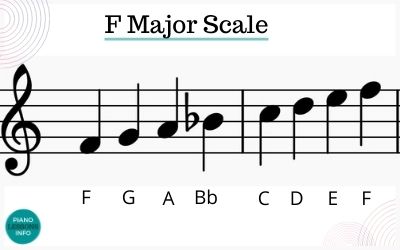
A major chord is built on the 1st, 3rd and 5th notes of the major scale. In this case, F, A and C. We are going to turn that major chord into a minor chord.
To turn a major chord - F A C - we just need to take that middle note of the chord - A - and lower it one semi-tone. (That means to go to the very next note to the left.)
When we lower A by one semi-tone, we get Ab.
The chord formula for a minor chord is: 1 b3 5. (First, lowered third and fifth notes of the major scale.)
So this is how we get F Ab and C.
Fm Piano Key
Every minor key shares a key signature with a major key. In the case of F minor, it shares a key signature with Ab major.
The Ab and Fm piano key signature is 4 flats: Bb Eb Ab Db.
So, if you are playing in the key of Fm, you play in those 4 flats.
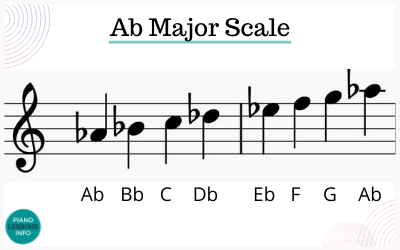
If you need more help understanding key signatures, visit the key signatures page.
If you need to look up more chords, visit the Piano Chord Charts page or download your own copy below.
Free Download:
Ultimate Chord Cheat Sheet

Subscribe below and get free access to the (printable) Ultimate Chord Cheat Sheet.
Recent Articles
-
Piano Notes Chart
Nov 20, 23 10:21 PM
Find a piano notes chart for treble clef and bass clef notes as well as the different types of notes. -
D Chord on Piano + Diagram, How To & Theory
Oct 24, 23 12:20 AM
Learn how to play the D chord on piano with diagram, fingering, D/A, D/F# and a theory explainer. -
Diminished Piano Chords: Chart & How to Make Them
Oct 09, 23 09:23 PM
Learn the different diminished piano chords and how to make them. Here you'll find both a diminished chord chart and an explanation.
- Home
- 14 Day Chord Challenge
- Fm Piano Chord
Free Download:
Ultimate Chord Cheat Sheet

Subscribe below and get free access to the (printable) Ultimate Chord Cheat Sheet.











